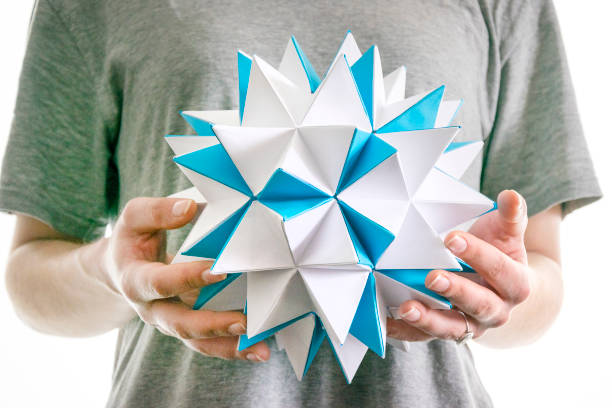
Few of us are confident in solving equations like x3 + 3 x2 – x+ 3 = 0, which is an equation to find the value of x.
The two activities share some common skills, including precision, the ability to follow an algorithm, intuition for form, and a search pattern and symmetry.
I am a mathematician who loves to fold paper. I enjoy introducing mathematical concepts through origami. Every piece of origami contains mathematical skills and ideas, which can lead you on an exciting, creative journey.
The building blocks of origami models
My favorite technique as a geometer is modular origami. It’s when you use multiple pieces of folded paper as a “building block” to create a bigger, often symmetrical design.
The units are usually easy to fold. Math skills are used to assemble larger structures and discover patterns.
Although they may have different units, many modular origami designs use a similar way to combine units into a larger creation.
For a small amount of effort, you can explore a wide range of models.
My website, Maths Craft Australia, has a variety of modular origami designs, as well as patterns for other crafts, such as crocheting, knitting, and stitching.
You don’t need to have any mathematical background, but you will be taught some interesting mathematical concepts.
Building 3D shapes using smaller 2D units
The platonic solids are the mathematical shapes that have the greatest symmetry. The solids are named after the ancient Greek philosopher Plato, although they were discovered by ancient civilizations all over the world.
Platonic Solids are 3D forms made of regular 2D shapes, also known as regular polygons. Each side and angle must be identical.
There are an infinite number of regular polygons. However, there are only five Platonic Solids.
- The tetrahedron is made up of four triangles.
- The cube (six-squared)
- The octahedron is made up of eight triangles.
- The dodecahedron (12 Pentagons).
- The icosahedron is made up of 20 triangles.
The Sonobe units are the perfect place to begin if you want to build Platonic Solids in origami.
Enter the sonobe unit.
The sonobe (also called the sonobe modules) is shaped like a parallelogram with two flaps behind it.
There are many videos on the internet, including this one.
Sonobe units can be folded quickly and easily and then fitted together to form beautiful and intriguing 3D shapes like these.
Six snobs are needed to build a cube, like the one shown above in yellow-blue-green. Twelve units will make an Octahedron or the red-pink purple-orange one. Thirty teams will make an Icosahedron. It’s interesting to note that sonobe units cannot be used to create a dodecahedron or tetrahedron.
You can find the instructions to build the larger models by searching the internet.
In the rabbit hole of mathematics
After you have mastered each 3D shape’s basic structure, you might find yourself (as other people have done) pondering more complex mathematical questions.
If you have only three colors, can you arrange your sonobe so that two units of the same color will never touch each other?
Are larger symmetric shapes possible? (Answer: yes!)
What are the relationships between 3D shapes? Can you find the hidden pentagons in the icosahedron? You can also find triangles within the dodecahedron.
A seemingly innocent question could easily lead down a rabbit hole of mathematical calculations.
You will learn about graphs, networks, and the big questions that have remained unanswered for centuries by asking simple coloring questions.
You can find the Johnson Solids by asking questions about larger models. The 3D shapes are symmetrical but do not have as much symmetry as the Platonic Solids.
You might also consider the concept of higher dimensional symmetric forms.
You may find that your questions lead you in a different direction.
Some researchers have explored new ideas in origami using mathematical frameworks instead of origami.
Solving old problems with new methods
The US-based former NASA scientist Robert Lang is perhaps the most famous mathematical artist. He designs computer programs to generate crease patterns that allow for incredibly complex models.
He has created tarantulas, ants, and stags with twisted horns, as well as soaring birds and feathered stags.
Robert Lang, along with others, has also developed crease patterns that can be used in new engineering contexts, like folding telescopic lenses, airbags, and panels of solar energy.
My final example of the power of origami goes back to the cubic equation I mentioned at the outset:
=3 + 3 =2 + = + 3 = 0
Cubic equations are related to “impossible” mathematical problems such as trisecting an angle, which is dividing an arbitrary angle into three equal angles. Or doubling the cube.
These problems are notoriously impossible to solve using the traditional methods of straightedges (rulers without markings) or compasses.
Hisashi Abe, a Japanese mathematician, demonstrated in 1980 how they could solve these problems by using origami.
I’m excited to see how mathematics and origami intersect in the future. Grab some paper and make a few origami models today to begin your journey into mathematical exploration.
